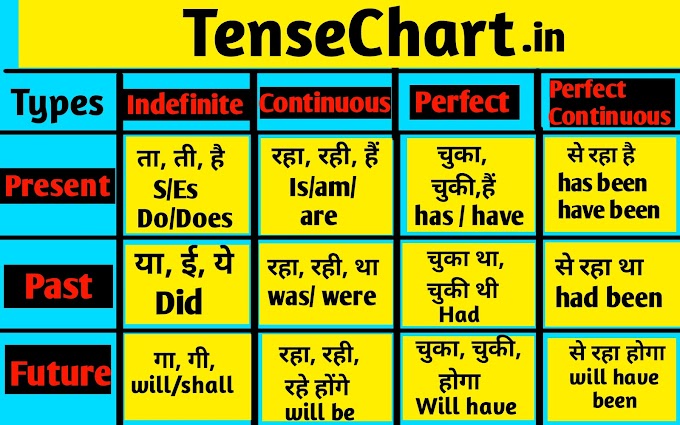Tense Chart: Tense is the backbone of English. If we do not know Tense in English then we can never speak correct English, it is very important for us to understand Tense chart. From the time chart we come to know about all the tense at a glance. There are basically three types of tenses: present tense, past tense, future tense and all three have 4 sub-parts: indefinite, continuous, perfect, perfect continuous. Let us see what is called time.
Definition Of Tense
The form of the verb which tells about the time of action or happening is called tense. That variation of a verb is called tense, which indicates the time of its action and its complete or incomplete state of belief. In other words, tense means ‘time’.Example
1. Tina is studying.
2. Monica had drawn a good picture.
3. Mukul will go to Amritsar with friends.
In the given sentences, colored words indicate the action happening at different times. In the first sentence the action is happening at the same time. In the second sentence, the action has happened in the past time. In the third sentence, the work is being reported to be done in the coming time.
Types of Tense
In English Grammar, tenses are of three types, that is,
- Present Tense
- Past Tense
- Future Tense
Further, it consists of four forms:
- Indefinite (Simple)
- Continuous
- Perfect
- Perfect Continuous
So, in total there are 12 tenses which are as follows:
| Tense | Sub Parts |
|---|---|
Present Tense | 1. Present Indefinite 2. Present Continuous 3. Present Perfect 4. Present Perfect continuous |
Past Tense | 1. Past Indefinite. 2. Past Continuous. 3. Past Perfect. 4. Past Perfect continuous . |
Future Tense | 1. Future Indefinite 2. Future Continuous 3. Future Perfect 4. Future Perfect continuous |
Below is the table of the examples of tenses
| Tense | Forms | Examples |
|---|---|---|
| 1. Present Indefinite | He drinks a water | |
| Present Tense | 2. Present Continuous | He is drinking a water |
| 3. Present Perfect | He has drunk a water | |
| 4. Present Perfect continuous | He has been drinking a water since morning |
| 1. Past Indefinite | He drank a water | |
| Past Tense | 2. Past Continuous. | He was drinking a water |
| 3. Past Perfect. | He had drunk a water | |
| 4. Past Perfect continuous . | He had been drinking the water since 7 am |
| 1. Future Indefinite | He will drink a water | |
| Future Tense | 2. Future Continuous | He will be drinking a water |
| 3. Future perfect | He will have drunk a water | |
| 4. Future perfect continuous | He will have been drinking the water at 6 am tomorrow |
Significance of Tense Chart
The English Grammar, tenses are often considered an important concept. A verb when changing its form takes the help of tense to formulate the proper sentence or express the state of action, events, or occurrence in a proper way. It helps you to make your context clear and precise. You may also create complex sentence constructions using tenses. Therefore, you should be familiar with all twelve tenses and their usage, so for that, we have made a tense chart below to make you understand better
| Present Tense | Farmula & Rules | Examples |
|---|---|---|
Present Indefinite tense | Subject + Verb in the base form/third person plural form + the rest of the sentenc |
|
Present continuous tense | Subject + Helping Verb(am/is/are) + Main verb + ing + the rest of the sentence |
|
Present perfect tense | Subject + Helping Verb (have/has) + Past participle of the main verb + the rest of the sentence along with the time frame |
|
Present perfect continuous | Subject + Have/Has + Been + Verb+ ing + the rest of the sentence |
|
| Past tense | Rules | Examples |
|---|---|---|
Past indefinite | Subject + Verb + ed / verb in the past tense + the rest of the sentence |
|
Past Continuous | Subject + Helping Verb(was/were) + Main verb + ing + the rest of the sentence |
|
Past Perfect | Subject + Helping Verb (had) + Past participle of the main verb + the rest of the sentence along with the time frame. |
|
Past Perfect continuous | Subject + Had + Been + Verb + ing + the rest of the sentence |
|
| Future tense | Rules | Examples |
|---|---|---|
Future indefinite | Subject + will/shall + V1 + Object |
|
Future continuous | Subject + will be/shall be + V1 + ing + Object |
|
Future perfect | Subject + will have/shall have + V3 + Object |
|
Future perfect continuous | Subject + will have been + V1 + ing + Object |
|






